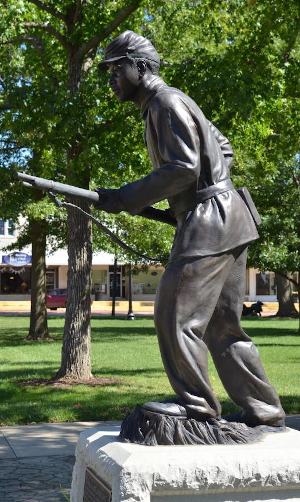
About that First Kansas Colored Volunteer Infantry
By John LaRoe, 5 February 2021

|
|
First Kansas Colored Volunteer Infantry Memorial |
There is, in Butler, MO, a Civil War sculpture that belongs in the public square. It memorializes genuine heroes, commemorates their courageous acts in defense of the Union, and preserves real history in its plaque, which reads:
'First Kansas Colored Volunteer Infantry'
The 1st Kansas Colored Volunteer Infantry fought and won the Battle of Island Mound, also known as The Battle of Fort Toothman, on October 28 & 29, 1862 in Charlotte Township approx 7.5 miles southwest of Butler. It is said to have been the only battle fought on Bates County soil in which regular U.S. troops were involved. The First Kansas Colored Volunteer Infantry was the first black unit to fight in the Civil War. Reportedly, Southern rebels outnumbered the black troops five to one, attacked the fort and fierce hand-to-hand combat ensued. Of [them] it was written, 'They Fought Like Tigers.'
Volunteers were recruited into the 1st (& 2nd) Kansas Colored Infantry in 1862, making Kansas the first Northern state to recruit and train Black soldiers into a state's military service in the Civil War. But the units could not be mustered into federal service until the Emancipation Proclamation, which also authorized the recruitment of Black troops, was announced at the end of that year. (NPS)
On hearing of the recruiting of Blacks to serve as soldiers, Confederate commanders issued a general order (21 August 21 1862) that "crimes and outrages" such as that merited "retaliation." Any Union officer captured in command of Black troops, it was ordered, would be "executed as a felon." Southern troops would take no Black prisoners. They would, at best, be returned to slavery, but more likely would be slaughtered if captured (Carle).
By that time, the 1st Kansas had already been sent into battle, at Island Mound (aka Fort Toothman).
Captain William D. Mathews, commanding Company D of 1st Kansas Colored Volunteer Infantry Regiment, spoke in celebration of the unit's incorporation as a federal unit on 1 January 1863:
Today is a day that I always thought would come ... Now is our time to strike. Our own exertions and our own muscle must make us men. If we fight we shall be respected. I see that a well-licked man respects the one who thrashes him. (NPS)
Battles in which the 1st Kansas Colored Volunteer Infantry fought:
- Island Mound, near Butler, Missouri (28 October 1862)
- Rader's Farm, near Sherwood Missouri (18 May 18, 1863)
- Cabin Creek, Indian Territory (July 1-2, 1863)
- Honey Springs, Indian Territory (July 17, 1863)
- Poison Springs, Arkansas (April 18, 1864)
- Flat Rock Creek, Indian Territory (September 16, 1864)
- Timber Hills, Indian Territory (November 19, 1864) (NPS & Murphysburg.Org).
In one of the Confederacy's most notorious atrocities of the war, Southern soldiers killed 117 and wounded 65 members of the 1st at Poison Springs, slaughtering and mutilating many of them as they lay wounded; and "Remember Poison Springs!" became a battle cry of Black troops serving in Union ranks in the West through to the end of the war (NPS & Carle).
At Cabin Creek, in the Indian Territory, the 1st Kansas Colored became the first Black troops to fight alongside white troops in the Civil War (Carle).
Following the Battle at Honey Springs, Major General James G. Blunt described their performance in that battle like so: "I never saw such fighting as was done by that Negro regiment. ... they make better soldiers in every respect than any troops I have ever had under my command" (Carle).
Sources & Resources
- National Park Service (NPS). First to Serve: a description of the unit's celebration of the Emancipation Proclamation on 1 January 1863 at Fort Scott, KS, including an excerpt from remarks by Captain William D. Mathews, commanding Company D of 1st Kansas Colored Volunteer Infantry Regiment, hosted & maintained by the National Park Service for the Fort Scott Historic Site. You have to check out the photo of Captain Mathews on the Fort Scott site. The guy is a total bad ass.
- Murphysburg.Org. Sherwood/Rader Farm Civil War Park: Article describing the battle at Rader's farm and the park established at the site in 2009 in Jasper County.
- Carle, Glenn L. The First Kansas Colored: An excellent American Heritage article describing the unit: its recruitment, its valor in battle (with particular attention to Cabin Creek), its treatment by the Department of the Army throughout the war (not good), atrocities commited against it.
- Barker, Kimberly. Historian spotlights the story of the 1st Kansas Colored Infantry in Civil War series: a Joplin Globe article reporting on a lecture series by historian Ian Michael Spurgeon on the unit. Spurgeon is the author of the Soldiers in the Army of Freedom: The 1st Kansas Colored, the Civil War's First African American Combat Unit.
- LaRoe, John. Battle Of Island Mound Missouri State Historic Site commemorating the first time African American troops saw combat in the Civil War (2 September 2017, Facebook album, 6 photos).
- Kansas Historical Society (KHS). First Kansas Colored Infantry: An article about the unit on Kansaspedia, a web site authored and maintained by the Kansas Historical Society.
- Wikipedia. Battle of Poison Spring: an article describing the battle and providing links to additional resources.
- First Kansas Colored Volunteer Infantry: a brief article about the unit, with several quotations regarding its good reputation and a book recommendation.
- 1st Kansas Colored Volunteers (Later the 79th U.S. Colored Infantry): a list of resources available at the Kansas City, MO, Public Library, maintained by the Library
- First Kansas Colored Infantry (1862-1865): a brief article about the unit on the BlackPast web site.
- Update: Wikipedia article on the Skirmish/Battle at Island Mound. (Wikipedia describes this engagement as a skirmish rather than a battle. The resource defines the distinction between a battle and a skirmish as follows: "a battle is a military engagement that is well defined in duration, area, and force commitment. An engagement with only limited commitment between the forces and without decisive results is sometimes called a skirmish." I think that sells the 1st Kansas Colored's first engagement short, to be honest. The fighting was deliberate as its details and its aftermath beyond the field of engagement were significant.)
©2008-2021 LaRoeDotCom.
All rights reserved.
Email LaRoe at this domain.